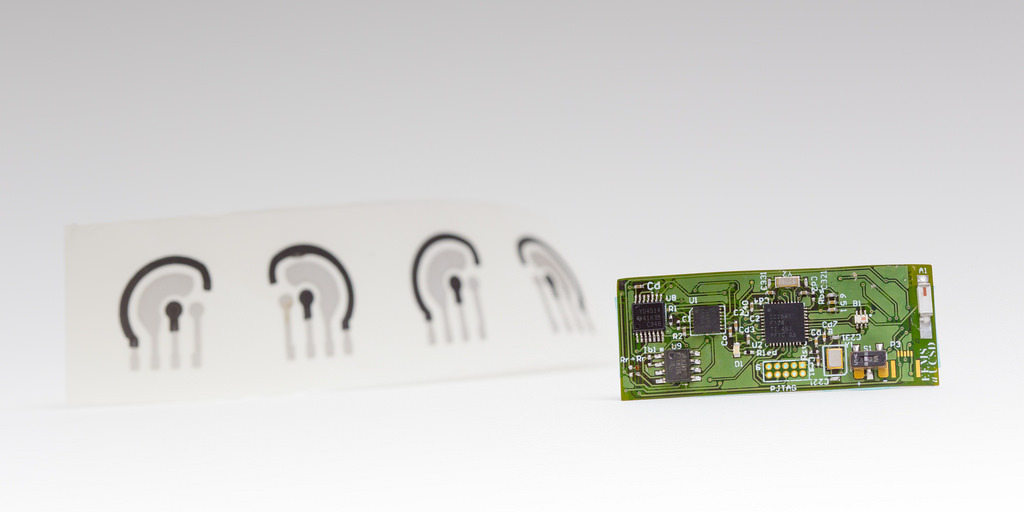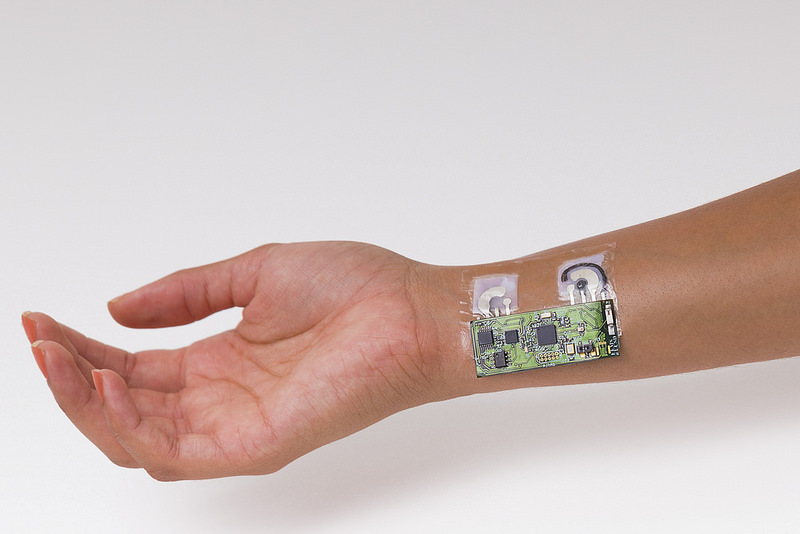Electronic tattoo will show the degree of intoxication
For the first time, a wearable device was created that quickly determines the blood alcohol content

Illustration: University of California, San Diego
Engineers from the University of California at San Diego have designed a very useful device . It is useful to many men and women who for the weekend were in a difficult situation and forced to poison the body with alcoholic beverages. The device is a flexible electronic sensor and tattoo that accurately measures the level of alcohol in the blood (sweat) and transmits information to a laptop, smartphone or other mobile device via Bluetooth.
According to the inventors, such a sensor can be used by doctors or police officers for continuous non-invasive monitoring of individuals who are prohibited from drinking alcohol in large quantities. In any totalitarian society, one can imagine that such tattoos will be made to all drivers upon receipt of rights, and the car simply refuses to start if the level of alcohol in human blood is higher than the allowed value.

Photo: University of California, San Diego
')
The device consists of 1) a temporary tattoo that “sticks” to the skin, stimulates sweating and determines the alcohol content by an electrochemical method; 2) an electronic board that is attached to the tattoo with a magnet and can transmit information via Bluetooth.
The inventors are Joseph Wang, a professor of nanoengineering at the University of California at San Diego, and Patrick Mercier, a professor of electrical engineering.
“A large number of traffic accidents occur due to drunk driving. This technology provides an accurate, convenient and fast way to track the amount of alcohol consumed, to prevent car driving under the influence of this substance, ” says Professor Wang. He suggests that the car ignition system can be integrated via Bluetooth with the developed sensor. If for all cars to introduce such a system is unrealistic, but it is quite possible to put it on a court order on the cars of drivers who have ever been convicted of driving while intoxicated. Perhaps this will help save human lives.
In addition to automotive applications, such a device is simply useful for self-control, since it clearly shows the amount of alcohol consumed. The smartphone can vibrate or beep when it reaches a predetermined level. The system will be useful for remotely monitoring the behavior of the husband / wife or it can be used for a variety of alcohol games and online competitions.
Typically, the blood alcohol content is measured using an alcohol tester for the content of ethanol in exhaled breath vapors, but this is not a very accurate test that can give false positives. For example, measuring directly after taking an alcoholic drink shows an overestimated level compared to the actual alcohol content in the blood. In addition, this breathalyzer can be easily deceived if you rinse your mouth before checking or use a breath freshener.
In previous years, attempts were made to develop wearable sensors that reliably measure the level of alcohol in the blood, but these devices (SCRAM and Giner WrisTAS) had a significant drawback: the test time was too long compared to standard breathalyzers (from half an hour to two hours) [one] [2] . A compact device that monitors in real time would become extremely popular, which encouraged the authors of this invention to conduct research.
The developed device contains a temporary tattoo, through which pilocarpine is injected into the skin to stimulate sweating, and then the alcohol content is determined by iontophoresis and amperometry. Sweat comes into contact with an electrode coated with an alcohol-oxidase enzyme, which selectively reacts to ethanol to form hydrogen peroxide, which is determined by an electrochemical method.

Illustration: University of California, San Diego
The developed biosensor demonstrates an extremely selective and accurate response to ethanol. Information enters the electronic board in the form of electrical impulses. The data is then transmitted to the mobile device using a wireless transmitter.

Photo: University of California, San Diego
“What else is new in our method is that the user does not need to exercise or sweat. The person installs the device, and after a few minutes [after about 15 minutes] he receives readings that correlate well with the alcohol content of his blood. Until now, such devices did not exist, ”says Professor Mercier.
The device was tested on 9 volunteers who took different amounts of alcohol - in all cases the readings were relatively accurate. The device works fine regardless of the movement of the carrier.
Now the researchers have set the task to improve the device so that it can work and measure the blood alcohol content continuously for 24 hours.

Photo: University of California, San Diego
Blood alcohol content is very important information, because a person’s behavior and life directly depend on this concentration. The alcohol content is measured in ppm (‰, thousandths of a volume). For example, a concentration of 1.0 (ppm) means that a liter of blood contains 1 milliliter of pure ethanol and 999 milliliters, in fact, blood.
The consequences of alcohol poisoning of varying severity are shown in the table .
| Effects of different blood alcohol levels | ||
|---|---|---|
| Blood alcohol level (content,) | Behavior | Violations |
| 0.2-0.29 |
|
|
| 0.30-0.59 |
|
|
| 0.6-0.9 |
|
|
| 1.0-1.9 |
|
|
| 2.0-2.9 |
|
|
| 3.0-3.9 |
|
|
| 4.0-5.0 |
|
|
| > 5.0 |
| |
The scientific work “Non-invasive tracking of alcohol using a wearable system based on iontophoresis besensor tattoos” was published on July 12, 2016 in the journal ACS Sensors (doi: 10.1021 / acssensors.6b00356).
[1] Swift, RM; Martin, CS; Swette, L .; Laconti, A .; Kackley, N. Studies on a wearable, electronic, transdermal alcohol sensor. Alcohol. Clin. Exp. Res. 1992, 16, 721-725. Back to article
[2] Leffingwell, TR; Cooney, NJ; Murphy, JG; Luczak, S .; Rosen, G .; Dougherty, DM; Barnett, NP Continuing measurement using transdermal sensors. Alcohol. Clin. Exp. Res.2013. 37, 16-22. Back to article
Source: https://habr.com/ru/post/396693/
All Articles